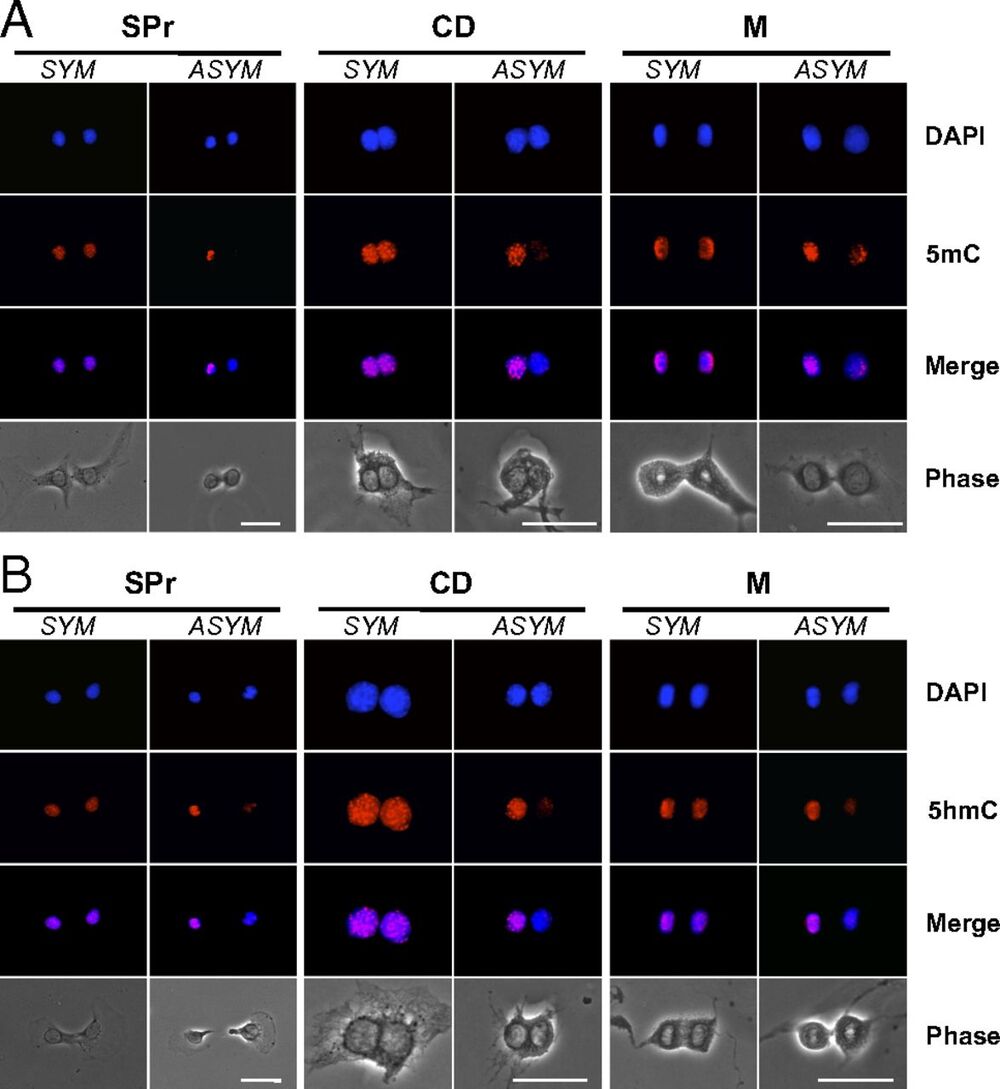Astronomers estimate 29 habitable planets are positioned to see Earth transit and intercept human broadcasts.



Immortality DNA strands found in humans.
Distributed stem cells (DSCs), which continuously divide asymmetrically to replenish mature tissue cells, adopt a special form of mitotic chromosome segregation. Chromosome segregation is nonrandom instead of random. DSCs cosegregate the set of sister chromosomes with the older of the two template DNA strands used for semiconservative DNA replication during the preceding S phase. Neither the responsible molecular mechanisms nor the cellular function of nonrandom segregation are known. Here, we report evidence that immortal strand chromosomes have a higher level of cytosine 5-hydroxymethylation than mortal chromosomes, which contain the younger DNA template strands. We propose that asymmetric chromosomal 5-hydroxymethylation is a key element of a cellular mechanism by which DSCs distinguish older DNA template strands from younger ones.
Immortal strands are the targeted chromosomal DNA strands of nonrandom sister chromatid segregation, a mitotic chromosome segregation pattern unique to asymmetrically self-renewing distributed stem cells (DSCs). By nonrandom segregation, immortal DNA strands become the oldest DNA strands in asymmetrically self-renewing DSCs. Nonrandom segregation of immortal DNA strands may limit DSC mutagenesis, preserve DSC fate, and contribute to DSC aging. The mechanisms responsible for specification and maintenance of immortal DNA strands are unknown. To discover clues to these mechanisms, we investigated the 5-methylcytosine and 5-hydroxymethylcytosine (5hmC) content on chromosomes in mouse hair follicle DSCs during nonrandom segregation. Although 5-methylcytosine content did not differ significantly, the relative content of 5hmC was significantly higher in chromosomes containing immortal DNA strands than in opposed mitotic chromosomes containing younger mortal DNA strands.


Lawyers and venture capitalists said DeFi inhabits a largely unregulated grey area that could face pressure from the new Securities and Exchange Commission chair Gary Gensler. Some investors drew comparisons between DeFi and the boom in initial coin offerings four years ago, which collapsed following interventions by regulators.
Wave of ‘DeFi’ projects aim to reinvent exchanges, insurance, lending and more.

Daniel Schmachtenberger is a philosopher and founding member of The Consilience Project. Please support this podcast by checking out our sponsors:
- Ground News: https://ground.news/lex.
- NetSuite: http://netsuite.com/lex to get free product tour.
- Four Sigmatic: https://foursigmatic.com/lex and use code LexPod to get up to 60% off.
- Magic Spoon: https://magicspoon.com/lex and use code LEX to get $5 off.
- BetterHelp: https://betterhelp.com/lex to get 10% off.
EPISODE LINKS:
Daniel’s Website: https://civilizationemerging.com/
The Consilience Project: https://consilienceproject.org/
PODCAST INFO:
Podcast website: https://lexfridman.com/podcast.
Apple Podcasts: https://apple.co/2lwqZIr.
Spotify: https://spoti.fi/2nEwCF8
RSS: https://lexfridman.com/feed/podcast/
Full episodes playlist: https://www.youtube.com/playlist?list=PLrAXtmErZgOdP_8GztsuKi9nrraNbKKp4
Clips playlist: https://www.youtube.com/playlist?list=PLrAXtmErZgOeciFP3CBCIEElOJeitOr41
OUTLINE:
0:00 — Introduction.
1:31 — Aliens and UFOs.
20:15 — Collective intelligence of human civilization.
28:12 — Consciousness.
39:33 — How much computation does the human brain perform?
43:12 — Humans vs ants.
50:30 — Humans are apex predators.
57:34 — Girard’s Mimetic Theory of Desire.
1:17:31 — We can never completely understand reality.
1:20:54 — Self-terminating systems.
1:31:18 — Catastrophic risk.
2:01:30 — Adding more love to the world.
2:28:55 — How to build a better world.
2:46:07 — Meaning of life.
2:53:49 — Death.
2:59:29 — The role of government in society.
3:16:54 — Exponential growth of technology.
4:02:35 — Lessons from my father.
4:08:11 — Even suffering is filled with beauty.
SOCIAL:
- Twitter: https://twitter.com/lexfridman.
- LinkedIn: https://www.linkedin.com/in/lexfridman.
- Facebook: https://www.facebook.com/lexfridman.
- Instagram: https://www.instagram.com/lexfridman.
- Medium: https://medium.com/@lexfridman.
- Reddit: https://reddit.com/r/lexfridman.
- Support on Patreon: https://www.patreon.com/lexfridman

The homes we inhabit in the 2020s could serve as a personal headquarters for building the good society. How can a house help create a more positive future? Here are four ways the home of the future might support meaningful personal commitment to the greater good.
During the pandemic lockdown period, a new wave of civic engagement has taken hold. A trend called Advocate From Home (AFH) takes the form of digital organizing (e-mail, text banking, content production) for political, ecological, social and economic justice, often using work-from-home tools.


Sky surveys are invaluable for exploring the universe, allowing celestial objects to be catalogued and analyzed without the need for lengthy observations. But in providing a general map or image of a region of the sky, they are also one of the largest data generators in science, currently imaging tens of millions to billions of galaxies over the lifetime of an individual survey. In the near future, for example, the Vera C. Rubin Observatory in Chile will produce 20 TB of data per night, generate about 10 million alerts daily, and end with a final data set of 60 PB in size.
As a result, sky surveys have become increasingly labor-intensive when it comes to sifting through the gathered datasets to find the most relevant information or new discovery. In recent years machine learning has added a welcome twist to the process, primarily in the form of supervised and unsupervised algorithms used to train the computer models that mine the data. But these approaches present their own challenges; for example, supervised learning requires image labels that must be manually assigned, a task that is not only time-consuming but restrictive in scope; at present, only about 1% of all known galaxies have been assigned such labels.
To address these limitations, a team of researchers from Lawrence Berkeley National Laboratory (Berkeley Lab) is exploring a new tack: self-supervised representation learning. Like unsupervised learning, self-supervised learning eliminates the need for training labels, instead attempting to learn by comparison. By introducing certain data augmentations, self-supervised algorithms can be used to build “representations”—low-dimensional versions of images that preserve their inherent information—and have recently been demonstrated to outperform supervised learning on industry-standard image datasets.